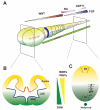Neural Subtype Specification from Human Pluripotent Stem Cells
- PMID: 27814479
- PMCID: PMC5127287
- DOI: 10.1016/j.stem.2016.10.015
Neural Subtype Specification from Human Pluripotent Stem Cells
Abstract
Human pluripotent stem cells (hPSCs) provide a model to study early neural development, model pathological processes, and develop therapeutics. The generation of functionally specialized neural subtypes from hPSCs relies on fundamental developmental principles learned from animal studies. Manipulation of these principles enables production of highly enriched neural types with functional attributes that resemble those in the brain. Further development to promote faster maturation or aging as well as circuit integration will help realize the potential of hPSC-derived neural cells in disease modeling and cell therapy.
Copyright © 2016 Elsevier Inc. All rights reserved.
Figures





References
-
- Bardy C, van den Hurk M, Eames T, Marchand C, Hernandez RV, Kellogg M, Gorris M, Galet B, Palomares V, Brown J, et al. Neuronal medium that supports basic synaptic functions and activity of human neurons in vitro. Proceedings of the National Academy of Sciences of the United States of America. 2015;112:E2725–2734. - PMC - PubMed
-
- Borghese L, Dolezalova D, Opitz T, Haupt S, Leinhaas A, Steinfarz B, Koch P, Edenhofer F, Hampl A, Brustle O. Inhibition of notch signaling in human embryonic stem cell-derived neural stem cells delays G1/S phase transition and accelerates neuronal differentiation in vitro and in vivo. Stem Cells. 2010;28:955–964. - PubMed
Publication types
MeSH terms
Grants and funding
LinkOut - more resources
Full Text Sources
Other Literature Sources

